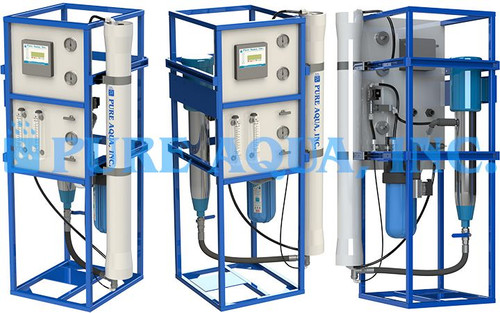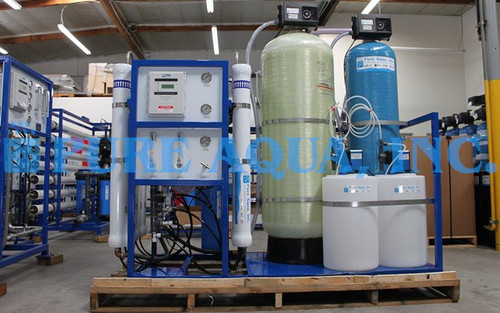Application: Well Water Treatment for TDS Reduction
This is model TW-43K-2380 from our RO-400 Series.
- RO system [RO-400 series]
- Microprocessor control panel
- High pressure stainless steel pump
- ORP monitor
- Well water feed
Since its initial startup, the RO system has been operating accordingly with minimal trouble-shooting. A reverse osmosis (RO) system is tasked with taking out large quantities of salts, and suspended solids, and other impurities through a process called “reverse osmosis”. Reverse osmosis is a pressure-driven technology utilized to strip out salt from water through a semi-porous membrane. Reverse osmosis takes advantage of a high pressure pump that applies extreme pressure to brackish or seawater against the surface of the semi-porous membrane transporting salt, suspended solids, and other impurities across the membrane resulting in the emergence of purified water on the lower-pressured side. Salt, and the rest of the impurities and are discharged into the brine stream and then flushed down a drain. The average reverse osmosis system comes equipped with pretreatments such as multimedia filters to remove particulates, activated carbon filters to take out chlorine, odor and color, a water softener with brine tank to take out hardness, and a UV sterilizer to kill bacteria.
[custom-specifications]
Water Challenges: A certain segment of the Philippines population depend on unstable, and unmaintainable water sources, such as well water with high TDS for their drinking water supply. Families living in areas with these contaminated water sources must spend long hours traveling to other regions to collect clean water. This situation reduces the overall country’s productivity, development, and educational level as young boys and girls must spend time to do these tasks in order to survive, rather than go to school. However, drinking water production has been steadily increasing in the Philippines as advanced water treatment systems, such as reverse osmosis has been distributed into the country to help produce more freshwater. The reverse osmosis process works by purifying untreated, contaminated water from various sources, with this certain application treating well water, and converting it into high quality drinking water.
[/custom-specifications]
[custom-features]
Applied Solution: This RO System was supplied to a major company in the Philippines. The objective was to produce drinking water with less than 500 ppm. The product water capacity was 43,000 GPD from well water of approximately 1,500 ppm TDS. The RO system was selected from our RO-400 series and came complete with microprocessor control panel, high pressure stainless steel pump, and an ORP monitor.
[/custom-features]
[custom-usage]
Low operating cost, compact size, reduced footprint, and high quality production of freshwater.
[/custom-usage]
RO System 43000 GPD - Philippines - Case Study[/custom-documents]
-
I was extremely excited to install a Pure Aqua, Inc. water system
Since we have our water system we feel better in all respects.
 ENGLISH
ENGLISH ESPAÑOL
ESPAÑOL العربية
العربية PORTUGUÉS
PORTUGUÉS FRANÇAIS
FRANÇAIS

















